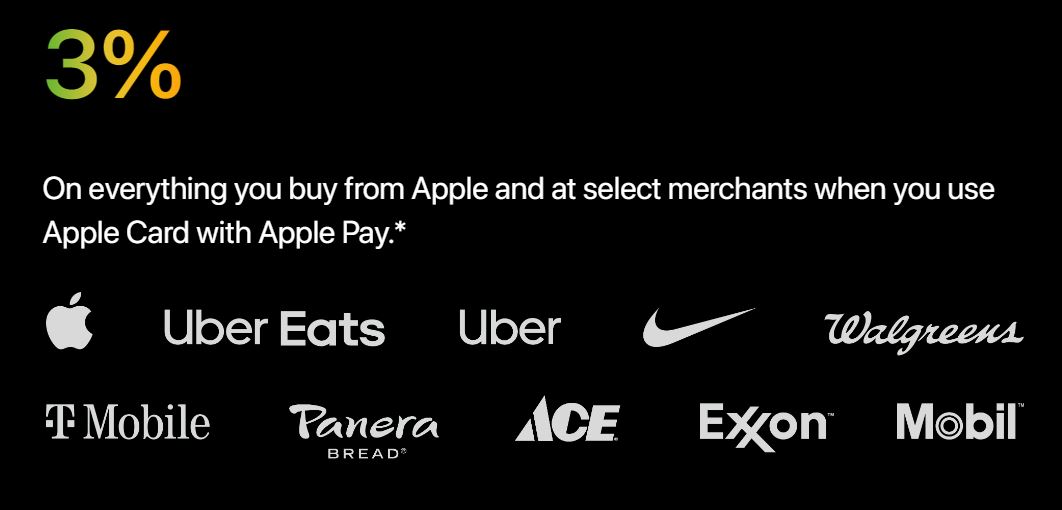
The Apple Card seems like a sweet deal for the iPhone crowd, with some caveats. To get the greatest value from this credit card, you'll need to pair it with the wallet app called Apple Pay and an Apple device to make purchases, such as an Apple Watch, iPhone or iPad.
In exchange for your fealty to Apple, you get 3% cash back on purchases of Apple and select other products, 2% back on most purchases, and 1% back if you use your card alone, without using Apple Pay.
By linking your Apple Cash wallet with a high-yield Apple Savings account (with an attractive interest rate of 4.1%), you can start saving your cash back seamlessly at a competitive interest rate.
That said, the Apple Card has been grievously mismanaged by Apple and its issuing partner, Goldman Sachs. The Consumer Financial Protection Bureau (CFPB) recently fined the companies $89 million for mishandling Apple Card transaction disputes. The Government agency also cited the companies for misleading iPhone purchasers about interest-free payment options.
So, should you get the Apple Card? I would recommend waiting until Apple unwinds its relationship with Goldman Sachs and institutes better internal safeguards for credit card customers. And though the Apple Card is attractive and extremely popular, it didn't make the cut in Kiplinger's analysis of the best rewards credit cards of 2024. I would instead recommend looking for a cash back or travel rewards credit card that delivers the best bang for your buck.
Apple Card overview
Pros
- Simplicity. With no points to track or travel miles to redeem, this card can save you time and brain cells.
- Encourages saving. Apple does a good job of helping you save money. When you elect to have cash back deposited in an Apple Savings account, your brain may be less likely to think of the cash as free money to spend. The Apple Savings account recently had an interest rate of 4.1% APY. While there are better high-yield savings accounts available, the rate is still well above the national average.
- No waiting for cash back. It's deposited every day into your Apple Cash or Apple Savings account.
- Rewards stacking. By combining your Apple Card with Apple Pay and the loyalty programs of participating merchants, you can score some great rewards. For example, get 3% cash back when you buy gas, car washes or convenience items at Exxon Mobil stations and earn Exxon Mobil Rewards+ points, which you can redeem against a future purchase.
- No fees. No annual fee, late fee or foreign transaction fee.
- Happy customers. The Apple Card won Best Co-Branded Credit Card for Customer Satisfaction with No Annual Fee in the J.D. Power 2023 U.S. Credit Card Satisfaction Study. And the Apple Cash payment app won first in its category in the 2024 Kiplinger Readers' Choice Awards.
- Security. The card and payment app are designed for enhanced security.
- Easy on the credit score. You can apply for the card and see your credit limit and interest rate without a hard pull on your credit. If you enroll, however, your credit score will be impacted, as is customary when applying for a card.
Cons
- Failure to follow consumer financial laws. Apple and bank issuer Goldman Sachs were fined $89 million in October 2024 for violations related to the Apple Card. This is a serious issue. Apple will likely improve its internal safeguards to avoid problems like this in the future, but is the card worth taking this gamble?
- No welcome or sign-up bonus. Some of the best credit card bonuses exceed $1,000 and other 2% flat rate cash back cards like Apple Card offer $200 bonuses.
- No purchase protection. Unlike other credit cards, like those in the Visa Signature line, this card does not come with purchase protection (typically 90 to 120 days of insurance against theft or damage, depending on the card). That's a real consideration if you plan to buy a laptop or iPhone with your card for the 3% back rate. iPhones, for example, come with a 90-day warranty. After 90 days, you can buy Apple Care insurance for up to $149 for two years of coverage. Credit cards like the Chase Freedom Flex, on the other hand, offer smartphone coverage up to $600 for free.
- Encourages spending. Yes, we just said that the card can help trick your brain into saving money, but it can also entice you to spend more. That's because people spend more money — almost 10% more on average — when using mobile payments than when paying a physical credit card. This type of "frictionless" payment is just so easy, you don't have as much time to pause and think about your spending.
- Not accepted everywhere. Most merchants accept Apple Pay. However, Walmart, Kroger, H-E-B and Sam's Club currently do not.
- Uncertain future banking partner. The Apple Card partners with Goldman Sachs, but that relationship soured back in 2023. It's unclear which, if any, financial institution will step in to sponsor the card, or if any rewards rates will change.
Current 3% back partners
Here are the recent merchants that pay 3% back when you pay with your Apple Card with Apple Pay. Note that these partners may change.

Who should get the Apple Card?
The card is best for people who have had an iPhone for a while and are committed to staying within the Apple product ecosystem. Better yet, if your spouse or family are also on iPhones, you can share the card with your family. You can share the card with another adult as a co-owner. And you can sign up anyone aged 13 to adult as a participant (similar to an authorized user). When used thoughtfully, credit cards for teens or young adults can help them build credit and learn the ropes of managing a credit card with some guardrails in place.
Rewards cards dos and don'ts
As with any rewards credit card, be sure to weigh these benefits against fees — although there are happily none in this case — and make sure you understand how to use the card effectively.
In addition, while reward credit cards are great if you use them wisely, always pay them off in full and on time each month to avoid interest, which can dwarf any rewards you earn. Don't change your spending habits to chase credit card rewards. That's a slippery slope that can lead to overspending.
If this is your first foray into credit cards, or you just want a refresher, make sure you know how to choose a credit card. And ensure you understand what counts as a good credit score.



!["[T]he First and Fifth Amendments Require ICE to Provide Information About the Whereabouts of a Detained Person"](https://images.inkl.com/s3/publisher/cover/212/reason-cover.png?w=600)



